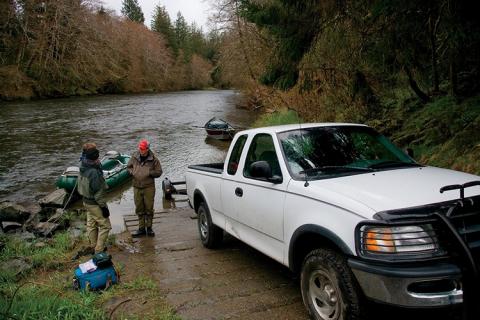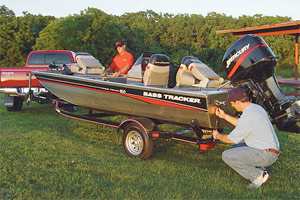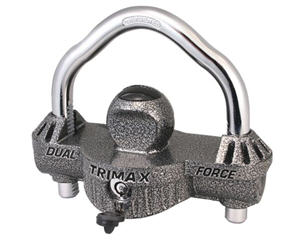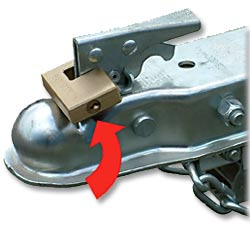
Boat launch activity can range from placid to pandemonium — or anywhere in between. Line-ups and on-the-ramp mishaps can send impatient individual's stress-levels soaring; conversely a vacant launch on a calm day is a welcome sight to any boater. Boat launches are often busy, but they don't have to be chaotic. Here are some tips for keeping your boat launch experiences running as smooth as the drag of a new fishing reel.
Homework: Ask Questions About the Boat Launch
 |
| Preparation is critical for boat launching to be a smooth operation |
A little digging can go a long way when it comes to using a launch for the first time. If you can, it's a good idea to inquire with local anglers, bait shop owners, or guides about the state of the launch. Questions to ask are: "Is it gravel or concrete launch? How many boats can be launched at a time? Is there a dock? Is the launch in good condition? Is there a fee? And if you have a larger boat, does it have the depth to handle it?
Knowing about a sub-par launch is important so you can be prepared, or simply avoid the shabby one and find a better ramp close by. Lastly, you'll want to make sure you get directions — driving in circles is a pain on a good day, but it's a lot worse when you're towing a boat and pressed for time!
Keep the Boat Trailer & Gear in Good Condition
Just as important as knowing about the launch you'll use, is being prepared with the right gear to get in and out of the water quickly and in a safe manner. It's essential that your trailer be in proper condition, including working lights, adequately-inflated tires with sufficient treads, as well as a winch, strap, and clip to keep the boat secure. If any of these items fail, you might not make it to the launch.
You will need the following gear when you're ready to launch: A bowline is critical for launching a boat alone or if you plan to secure it to the shore or a dock before departing. If needed, you should also have a spare line attached to the stern. If resting your boat against a dock, fenders and bumpers will protect it from damages caused by rocks. If you regularly beach your boat, consider investing in a KeelGuard to protect your hull. Don't forget to carry a spare plug and keys for your boat. Losing either of these can create a lot of disarray at a launch and quickly end a trip. Lastly, always carry the required safety equipment, especially life jackets, spare paddles, a signaling device, a bailer and a throw rope.![]() Tip: 10 Boating Essentials Under $25
Tip: 10 Boating Essentials Under $25
How-to Launch a Boat
Phase One: Preparing Your Boat
Preparation is critical for boat launching to be a smooth operation. Most launches have areas designated for pre- and post-launch activities. You should always use these areas and never (even if the launch is empty) do your preparations on the ramp itself. Local anglers living down the street could arrive and be ready to go before you are, and clogging a launch ramp simply equates to bad launch etiquette.

Before preparing your boat for launching, walk to the ramp itself and make sure it's suitable for your towing rig and boat. Steep gravel ramps might be too much for a vehicle with low horsepower and limited torque or bad weather conditions might make the ramp too dangerous to use.
When you prepare your boat, do the following — remove the tarp and any securing straps (like transom tie-downs). Load in any gear you haven't already put in the boat so you don't have to carry equipment. Check your boat plug to make sure it's in securely and also make sure the keys to the boat are in the console as well. Double-check the amount of gas you have (you should have already done this before you moved your trailer). Remove the safety strap (or chain) and winch strap connected to the bow eye and connect the bowline. You should also disconnect the wiring connector to the trailer, as brake light bulbs can burn out if the box leaks when underwater.
 |
| Launches that are void of activity make them prime spots for theft. Using a trailer hitch or coupler lock can reduce possible thievery. |
By now your boat should be ready for launching. Before you go any further, take a few minutes and go over the launching process with your boating partner (if you don't have a partner you might want to get help from someone at the launch). If launching a boat with a first time user handling the bowline, advise them to brace themselves for the weight of the boat - I've seen launch-novices taken off guard and pulled into the water by the force of a recently-launched boat.
Another option (used during tournaments) is to launch a boat with someone in it, so that once they enter the water they can start the engine and vacate the launch to make room for the next trailer. This is a great option, but should be done by boaters who know their boat is in good working condition.
Phase Two: The Boat Ramp and Water Entry
This should be the fastest of all three phases. Slowly drive your trailer towards the ramp, entering the water with caution. (Note: a launch ramp is not the place to practice reversing your trailer. If new to operating trailers, go to an empty parking lot and become proficient and confident at backing up your rig before heading to a launch for the first time).
When traveling down the ramp, avoid sudden braking, especially if you've removed all securing straps connecting the trailer and boat. If the launch ramp is concrete you may be able to drive with all four tires in the water; however, vehicles can easily get stuck in soft-bottomed (or natural) launches, so aim to keep the front tires on land.
Once the boat enters the water, continue to back-up the trailer, at a steady pace. Launches with sufficient depth will cause the trailer to drop out from underneath the boat, and the boat to float away by the momentum of the backing-up process. If the launch is shallow, you may need to get out of your vehicle and push your boat off into the water. (This is also the best option if launching the boat alone. If doing this make sure your boat is secure before leaving the ramp to park your vehicle).
As the boat floats off the trailer, double check that everything is alright with your partner before driving off. When accelerating off the ramp do so at a steady pace, but be sure to keep your eyes on your side mirrors. The reason is simple: mistakes happen. If you've followed the above suggestions it's likely you'll have an error-free launch, but if you've forgotten to unhook a strap or accidentally snagged the bowline with your trailer, you'll see it in the mirrors. Keeping your windows down and stereo off will also allow your partner to holler if anything is wrong. Once you know everything is ok, vacate the ramp so the next boater can use it.
Phase Three: Vehicle Parking, Leaving the Boat Launch
 After launching your boat, quickly park your vehicle and trailer. This should be a pretty simple operation, but keep a few things in mind. First, off launches can be busy places filled with families and moving rigs, so always drive with caution and be alert for youngsters. Second, try and minimize the footprint your vehicle and trailer leave when parked. I'm often amazed at how much space some people use when parking rigs on an angle, not backing up fully into a spot, or several other creative space-hogging maneuvers that leave other boaters shaking their heads. Third, keep in mind that as often as launches are busy, they can also be void of activity — making them prime spots for theft. Don't leave valuables in your vehicle and keep things out of site. Lastly, when parking your rig, make sure you use the parking brake, especially if on an incline.
After launching your boat, quickly park your vehicle and trailer. This should be a pretty simple operation, but keep a few things in mind. First, off launches can be busy places filled with families and moving rigs, so always drive with caution and be alert for youngsters. Second, try and minimize the footprint your vehicle and trailer leave when parked. I'm often amazed at how much space some people use when parking rigs on an angle, not backing up fully into a spot, or several other creative space-hogging maneuvers that leave other boaters shaking their heads. Third, keep in mind that as often as launches are busy, they can also be void of activity — making them prime spots for theft. Don't leave valuables in your vehicle and keep things out of site. Lastly, when parking your rig, make sure you use the parking brake, especially if on an incline.
Once you've parked the vehicle, pay any fees for using the facility (if needed) and get in your boat. When driving your boat from the launch, keep your eyes peeled for signs regulating no-wake zones. Of course, as a general rule, it's best to not blast-off from the launch to ensure you don't make waves for launch users. Also, most launches are close to shallow water; so don't let your enthusiasm get the best of you. Take your time and slowly drive to deeper water before getting on plane. Otherwise you might find yourself returning to the launch sooner than you think with a damaged motor and/or hull.
Extra Features to Make Boat Launching Easier
The trailer that comes with your boat will have all you need for launching, but some extra features will make life easier. I've already mentioned the importance of a bowline, fenders or bumpers, and proper safety equipment (such as life jackets), as well as duplicate spare parts (like trailer bulbs and a boat plug).
Tip: Shop Trailer Accessories at Bass Pro Shops
Add-on features for your trailer includes:
- Guide-ons and rollers will help direct your boat into proper position on your rig
- Cleats and clips to make securing your boat to docks and throw lines easier
- Coupler and tire locks to deter thieves
- Transom tie-down straps will keep your boat secure on the trailer
The above steps are some suggestions and tips on how-to safely launch your boat. To leave the water, all you need to do is reverse the procedure and remember that taking your time and being thorough will often result in a safer and quick exit than if you rush, which increases your change of making mistakes. These seasons, try the above tips to make launching a boat a breeze, but don't forget to be patient with new boaters while waiting in a line to use the ramps; we've all been there before.
- 23459 views

